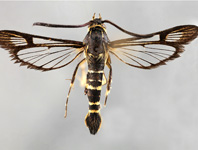Abstract
Three new species of the tribe Dactylotini (Acrididae: Melanoplinae) are described from Central and Southern Mexico. 1) Dasyscirtus monicae sp. nov. Fontana, Mariño-Pérez, Sanabria-Urbán, & Woller is described from the eastern portion of the Balsas River Basin and the outer slope of the Mexican Volcanic Belt; 2) Perixerus obscurus sp. nov. Fontana, Mariño-Pérez, Sanabria-Urbán, & Woller is described from the Sierra Norte de Oaxaca mountain range; and 3), Perixerus triqui sp. nov. Fontana, Mariño-Pérez, Sanabria-Urbán, & Woller is described from the Sierra Madre del Sur mountain range and towards the Pacific Coast of Oaxaca. Taxonomic placement of these species is justified based on distinct morphology and comparisons with congeneric species are provided. Finally, we provide a biogeographical explanation for the distribution of the species in both genera.
References
Bruner, L. (1908) Orthoptera. The Acrididae. Biologia Centrali-Americana, 2, 249–342.
Carbonell, C.S. (2000) Taxonomy and a study of the phallic complex, including its muscles, of Paulinia acuminata (Acrididae, Pauliniinae) and Marellia remipes (Acrididae, incertae sedis). Journal of Orthoptera Research, 9, 161–180.
https://doi.org/10.2307/3503647Carbonell, C.S., Mesa, A. & Condutta, V.L. (1980) Systematics and Karyotype of the Grasshopper Genera Omalotettix and Abracris. Proceedings of the Academy of Natural Sciences of Philadelphia, 132, 279–284.
Chapco, W. (2006) A note on the phylogenetic position of Duartettix montanus within the subfamily Melanoplinae. Journal of Orthoptera Research, 15, 59–63.
https://doi.org/10.1665/1082-6467(2006)15[59:ANOTPP]2.0.CO;2Chintauan-Marquier, I.C., Jordan, S., Berthier, P., Amédégnato, C. & Pompanon, F. (2011) Evolutionary history and taxonomy of a short-horned grasshopper subfamily: The Melanoplinae (Orthoptera: Acrididae). Molecular Phylogenetics and Evolution, 58, 22–32.
https://doi.org/10.1016/j.ympev.2010.07.003Cigliano, M.M., Braun, H., Eades, D.C. & Otte, D. (2017) Orthoptera Species File. Version 5.0/5.0. [13/I/2017]. Available from: http://Orthoptera.SpeciesFile.org (accessed 29 August 2017)
Fontana, P., Buzzetti, F.M. & Mariño-Pérez, R. (2011a) New Acrididae from Oaxaca State in Mexico (Orthoptera: Caelifera: Acrididae: Ommatolampinae, Melanoplinae). Zootaxa, 2862, 39–55.
Fontana, P., Buzzetti, F.M., Mariño-Pérez, R. & García-García, P.L. (2011b) Two new species of the Mexican genus Ichthyotettix Rehn, 1901 with remarks on the tribe Ichthyotettigini (Orthoptera, Caelifera, Pyrgomorphidae). Zootaxa, 2872, 18–34.
Fontana, P., Buzzetti, F.M., Mariño-Pérez, R. & García-García, P.L. (2011c) Three new species of Tettigoniidae from Mexico (Orthoptera: Tettigoniidae; Phaneropterinae; Insarini and Odonturini). Zootaxa, 2879, 22–32.
Gerstaecker, A. (1873) Acridiodea nonnulla nova insigniora. Stettiner Entomologische Zeitung, 34, 185–197.
Hebard, M. (1932) New species and records of Mexican Orthoptera. Transactions of the American Entomological Society, 58, 201–371.
Hebard, M. (1935) Records of Orthoptera and a new species of Perixerus (Cyrtacanthacrinae) from Guerrero, Mexico. Mitteilungen aus dem Zoologischen Museum in Berlin, 20, 444–446.
Morrone, J.J. (2005) Hacia una síntesis biogeográfica de México. Revista Mexicana de Biodiversidad, 76, 207–252.
Otte, D. (2007) Mexitettix and Mexacris, two new genera of grasshoppers from eastern Mexico (Acrididae: Melanoplinae). Proceedings of the Academy of Natural Sciences of Philadelphia, 156, 305–340.
https://doi.org/10.1635/0097-3157(2007)156[305:MAMTNG]2.0.CO;2QGIS Development Team (2017) QGIS Geographic Information System 2.14. Open Source Geospatial Foundation [15/II/2017]. Available from: http://qgis.org/en/site/ (accessed 29 August 2017)
Roberts, H.R. (1947) Revision of the Mexican Melanoplini (Orthoptera: Acrididae, Cyrtacanthacridinae) Part I. Proceedings of the Academy of Natural Sciences, Philadelphia, 99, 201–230.
Sanabria-Urbán, S., Song, H., Oyama, K., González-Rodríguez, A. & Cueva del Castillo, R. (2017) Integrative taxonomy reveals cryptic diversity in neotropical grasshoppers: taxonomy, phylogenetics, and evolution of the genus Sphenarium Charpentier, 1842 (Orthoptera: Pyrgomorphidae). Zootaxa, 4274 (1), 1–86.
https://doi.org/10.11646/zootaxa.4274.1.1Stål, C. (1873) Orthoptera nova descriptist. Öfversigt af Kongliga Vetenskaps-Akademiens Förhandlinger, 30, 39–53.
Woller, D.A., Fontana, P., Mariño-Pérez, R. & Song, H. (2014) Studies in Mexican Grasshoppers: Liladownsia fraile, a new genus and species of Dactylotini (Acrididae: Melanoplinae) and an updated molecular phylogeny of Melanoplinae. Zootaxa, 3793 (4), 475–495.
https://doi.org/10.11646/zootaxa.3793.4.6Woller, D.A. & Song, H. (2017) Investigating the functional morphology of genitalia during copulation in the grasshopper Melanoplus rotundipennis (Scudder, 1878) via correlative microscopy. Journal of Morphology, 278 (3), 334–359.
https://doi.org/10.1002/jmor.20642

